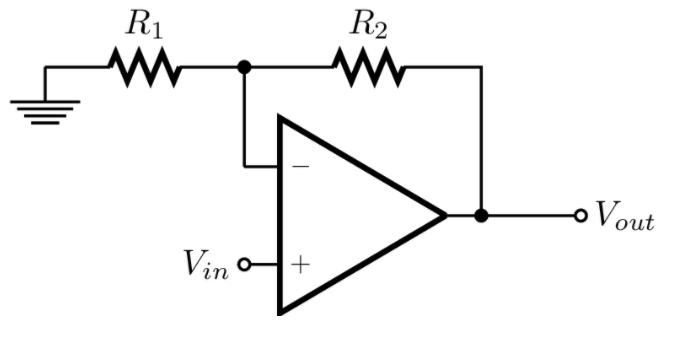
In an inverting amplifier circuit, the output voltage is expressed as a function of
(A) input current
(B) output current
(C) source voltage
(D) source current
Answer
123k+ views
Hint: In the inverting amplifier circuit the amplifier is connected with the feedback from the output to the input to form the closed loop. In the inverting amplifier circuit, there is no current flow into the input terminals. The input voltages both are the same.
Complete step by step solution:
Amplifier is an electronic device which is used to increase the amplitude of the signals, amplifier is used in the sound system as well as the communication system. An amplifier circuit is generally used in the control of the electronic circuits. For every circuit the applied input signal is in the form of voltage or current. The use of amplifiers in the electronic circuit is to produce the output signal which is larger than the input signal. If the input signal is in the form of voltage, the main purpose of the amplifier is to produce the more voltage of the output signal, likewise if the input signal is in the form of the current, then the main purpose of the amplifier is to produce the more current of the output signal.

The inverting amplifier is the normal operational amplifier, in the inverting amplifier the output is given as the feed back to the input by means of the resistor, so it makes the closed loop. If the input of the inverting amplifier is small voltage, the output of the inverting amplifier is very high voltage.
Hence, the option (C) is the correct answer.
Note: This large output gain is attained by the feedback to the inverting terminal of the input through a feedback resistor, by the feedback loop the overall gain of the output of the inverting amplifier is obtained. Now the inverting amplifier is said to be a closed loop which uses negative feedback to control the output.
Complete step by step solution:
Amplifier is an electronic device which is used to increase the amplitude of the signals, amplifier is used in the sound system as well as the communication system. An amplifier circuit is generally used in the control of the electronic circuits. For every circuit the applied input signal is in the form of voltage or current. The use of amplifiers in the electronic circuit is to produce the output signal which is larger than the input signal. If the input signal is in the form of voltage, the main purpose of the amplifier is to produce the more voltage of the output signal, likewise if the input signal is in the form of the current, then the main purpose of the amplifier is to produce the more current of the output signal.

The inverting amplifier is the normal operational amplifier, in the inverting amplifier the output is given as the feed back to the input by means of the resistor, so it makes the closed loop. If the input of the inverting amplifier is small voltage, the output of the inverting amplifier is very high voltage.
Hence, the option (C) is the correct answer.
Note: This large output gain is attained by the feedback to the inverting terminal of the input through a feedback resistor, by the feedback loop the overall gain of the output of the inverting amplifier is obtained. Now the inverting amplifier is said to be a closed loop which uses negative feedback to control the output.
Recently Updated Pages
How to find Oxidation Number - Important Concepts for JEE

How Electromagnetic Waves are Formed - Important Concepts for JEE

Electrical Resistance - Important Concepts and Tips for JEE

Average Atomic Mass - Important Concepts and Tips for JEE

Chemical Equation - Important Concepts and Tips for JEE

Concept of CP and CV of Gas - Important Concepts and Tips for JEE

Trending doubts
JEE Mains 2025: Check Important Dates, Syllabus, Exam Pattern, Fee and Updates

JEE Main Login 2045: Step-by-Step Instructions and Details

JEE Main Chemistry Question Paper with Answer Keys and Solutions

JEE Main Exam Marking Scheme: Detailed Breakdown of Marks and Negative Marking

JEE Main 2023 January 24 Shift 2 Question Paper with Answer Keys & Solutions

JEE Main Chemistry Exam Pattern 2025

Other Pages
JEE Advanced Marks vs Ranks 2025: Understanding Category-wise Qualifying Marks and Previous Year Cut-offs

JEE Advanced 2025: Dates, Registration, Syllabus, Eligibility Criteria and More

Learn About Angle Of Deviation In Prism: JEE Main Physics 2025

JEE Main 2025: Conversion of Galvanometer Into Ammeter And Voltmeter in Physics

Dual Nature of Radiation and Matter Class 12 Notes: CBSE Physics Chapter 11

Electric field due to uniformly charged sphere class 12 physics JEE_Main




